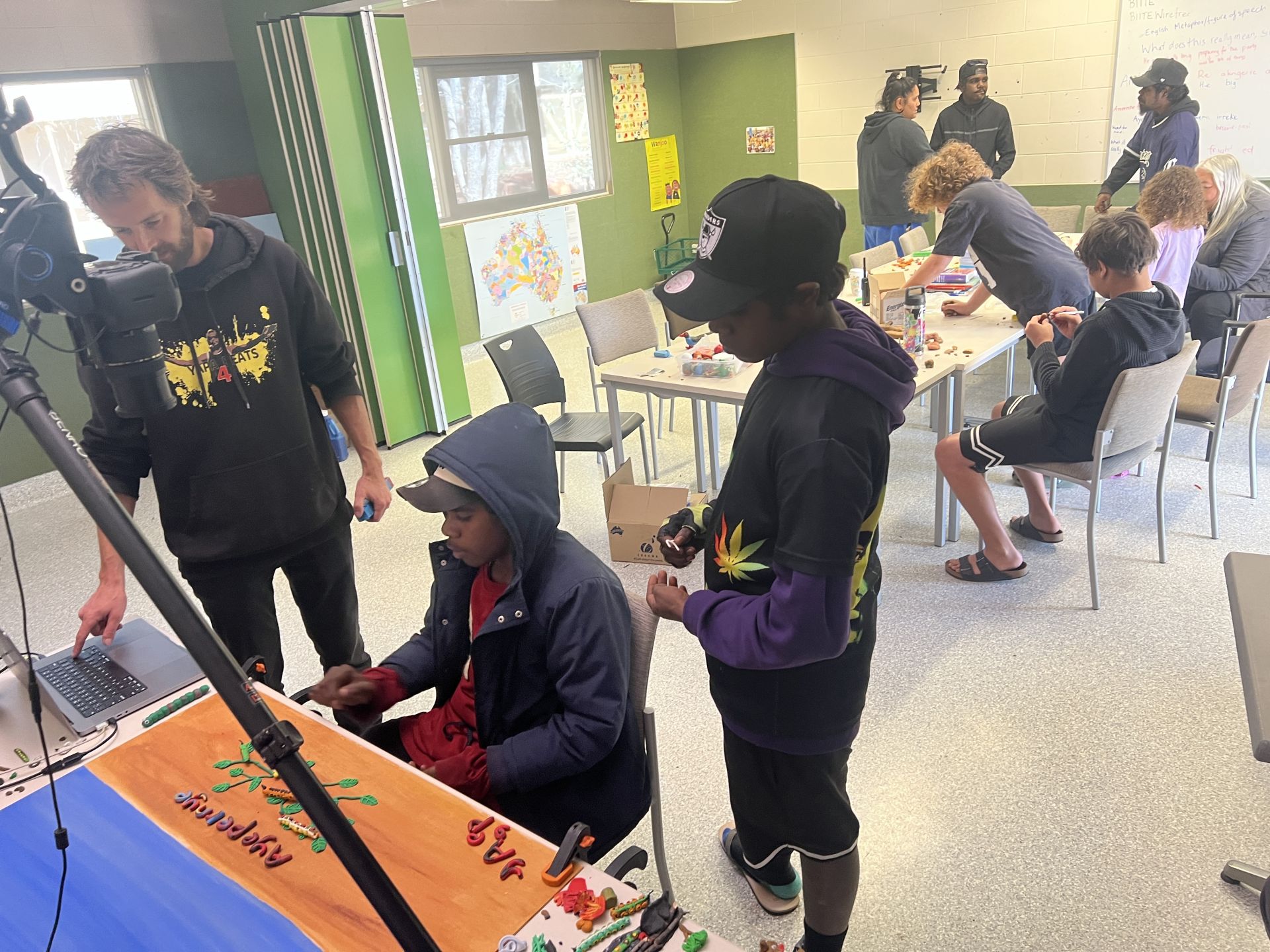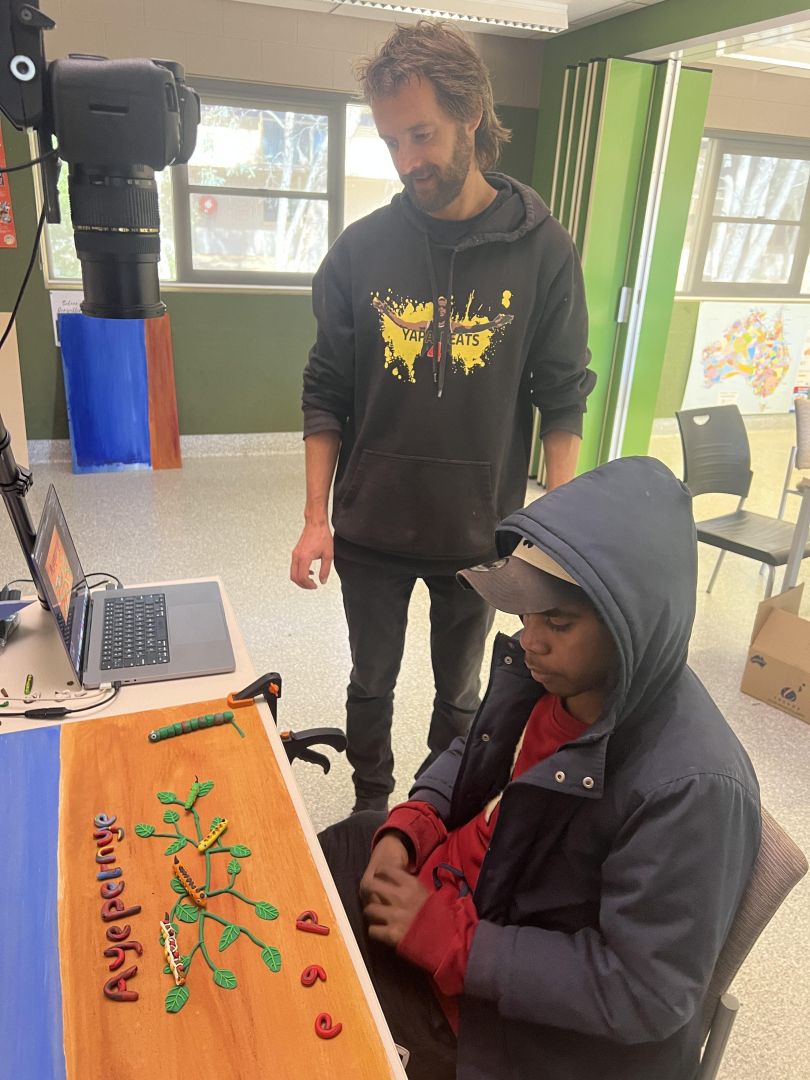
Last week, as part of the CALL ILA-funded Arne-kenhe ‘about trees’ project, CALL staff Camille and Ange, Arrernte knowledge holder Veronica Dobson, animator Jonathon Daw and a bunch of teenagers, using paint, plasticine and animation, brought to life four short stories about how seeds disperse and propogate.
Camille Dobson, senior project officer in the Batchelor Language Centre, CALL, with her mother Veronica Dobson, of Arrernte Dictionary fame & Angela Harrison, CALL Manager, undertook the workshop with the two-pronged objective of producing an animation to describe seed dispersal, while at the same time offering an animation workshop as a school holiday activity for Arrernte and other Aboriginal teenagers. As it turned out, we had 31 people participate during the week, both young people and parents and carers. It was a robust and diverse group who all appreciated the opportunity of an interesting, creative and culturally-relevant holiday-time activity. One and all contributed to producing a rich and beautiful claymation animated film.

Animator Jonathon Daw is experienced in working with communities to animate stories of cultural value within a workshop setting. The usual way of working is to have a story-teller or group of people filmed talking about the topic and then to engage young people in responding to the story in a creative workshop where they contribute to making the characters, backgrounds, maps, lettering etc., animating their own characters and recording sound effects. The ecological knowledge was told by Veronica Dobson and recorded by Jonathon Daw, with Camille Dobson and Angela Harrison, at the Olive Pink botanical gardens on 21st May 2025. Jono had then edited the stories down to four key examples of seed dispersal and propogation. The weeklong workshop was relaxed and offered various ways for the young people to be involved in contributing to the big picture.
The group watched the films of her telling each story and thought about the characters that would need to be made and backgrounds to be painted in order to animate the story. Each person would choose what they wanted to make or do. Once the young people had chosen their focus they got to work on their particular part of the story, and despite the number of teenagers in the room, the atmosphere was calm and quiet and everyone busy.
Feedback from one group of young people who were involved was that “everyone had a positive time making the models”.

This animation is a learning resource that will accompany the Arne-kenhe book that Camille and Veronica are working on. Both process and product aim to involve intergenerational learning and teaching of Indigenous ecological knowledge and generate situations where young people are learning from elders. The book will be a book for older students or adults, but the animation is a resource that can be enjoyed by young and old alike. The film tells of four seeds, the emu sush seed, utnarrenge annge, an example of seed dispersal by animals and birds, ayeperenye annge, the tarvine seed that is sticky and is spread when seeds get stuck onto animals, inernte annge, the batwing coral seed that iscarried by water ‘annge kwatyele anamelheme’, but also by people who make beads out of the colourful seeds, and the arlkerle annge, buck bush (rolly polly), which travels on the wind. Annge is the name for a non-edible seed.
Veronica was especially happy to be able to pass this on to future generations, saying “I was happy to have my grandkids there” while Camille commented that it was like “bring your family to work week”.
Over recent years, CALL has done a number of projects with animator Jonathon Daw, including the Talking Tracks series of animations, available on the CALL resources webpage. and the recent Utju School/Tangentyere/CDU/UniMelb collaboration animation, produced earlier this year to teach maths concepts in Pitjantjatjara (Video Below).
The Annge aname-irreme How Seeds Travel animation will be launched at the NAIDOC week ‘Let’s Talk Language’ Morning Tea at the Batchelor Campus in Alice Springs.
CALL provides opportunities for communities to carry out projects and activities that support their language aspirations. Anyone interested in doing work with their languages can use the planner in the CALL Plan (https://callprojects.org.au) to write up what they would like to do and then make contact with CALL staff in the Top End or Central Australia. CALL can help communities seek funding for their project and help them carry it out.
